The Diary of John Oram
In the autumn of 2012, I was given a DVD containing the scanned copy of the diaries of John Oram (1824-1907) and his son Arthur Oram (1853-1919). They were farmers and land agents who lived and worked in County Mayo, northwest Ireland. My interest lay primarily with the brief weather entries of John Oram, which to a meteorologist are fascinating. However it became clear that the record captured vividly (at least I thought so) the background social and political events in this part of Ireland as well. I have written the text published here that attempts to convey the important elements of the story. The diaries have been deposited with University College Dublin archives (see acknowledgements – below) and at some stage will be available for researchers to study online.
Variation of weather in time and space has an impact upon all life on the planet. Humans are particularly susceptible to such changes but often adapt in a marvellous and positive manner. However, there are instances where weather events varying outside what might be regarded as ‘reasonable’ limits have far-reaching historical, often tragic effects. One of the most significant led to the Great Irish Famine, generally regarded as beginning in 1845 and continuing for the next dozen or so years. The failure of the potato crop in that year in Ireland coupled with economic & political mismanagement, contributed to the deaths of about a million people from starvation and disease between 1846 and 1851 and the mass emigration from Ireland that followed is estimated at one-in-four of the pre-Famine population.
In 1853, when Ireland was experiencing a tentative recovery after the events outlined above, a 30 year-old English farmer, John Oram moved to County Mayo in Connaught, NW Ireland. He was born and raised in Somerset, England and came as the agent representing several landlords administering the estates on behalf of his employers, but he also had to farm the land in his own right and deal with the Irish climate in all its moods. The whole of the island was then part of the United Kingdom.
He kept a diary detailing the operations on his own farm, his dealings with the tenants and noting, on a day-by-day basis, the prevailing weather. As well as being a useful activity for his own purposes – he was a keen student of agricultural practice – it also helped when providing reports to landowners for whom he acted. As the years roll by it is clear that the vagaries of the climate become linked to increasing political turmoil.

Oram had two spells in this part of Ireland; from 1853 to 1873 he lived at Burrishoole (location B: Figure 1) and for 5 years, between 1877 and 1881, at Wilford (location W: Figure 1 below), a little further to the west along the coast. A copy of one page of the extensive diaries is shown as Figure 2. The weather entries are terse – often one word – and non-instrumental so at first sight they add little to the record. But occasionally events are described that amplify our knowledge of general conditions at the time. In this paper some of the highlights of his time in Ireland are described with extensive use of quotations from his diary, with the original spelling, punctuation etc. preserved. Direct quotes from the diary are italicised.
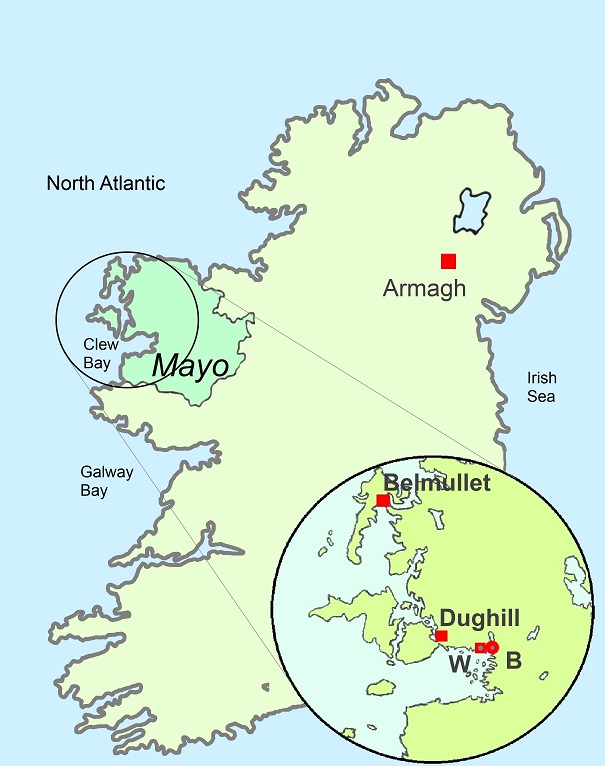
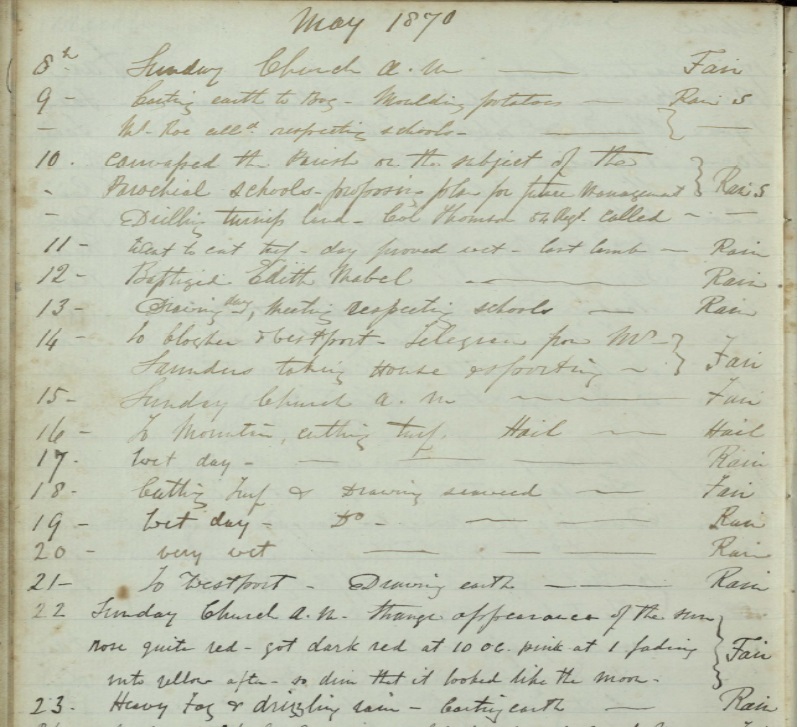
Figure 2. Extract from the diary for May 1870: the weather column entries are broadly self-explanatory. On 22 May Oram records the ‘strange appearance of the sun’; this phenomenon is discussed in more detail later. (Image reproduced with permission)
1855, Oram’s first full year of occupation, is remembered in Ireland as the year of the ‘Great Frost’. He records that January and most of February experienced . . . persistent cold, which seriously interfered with work on the farm. The cold weather obviously re-appeared in April as there was a significant impact on that year’s lambing though as often happens in spring, a rapid switch to hot and fair weather occurred later in the month.
The following year, 1856 is noteworthy for an implied extended cyclonic spell from mid-January to mid-February; a very high tide on 6 February associated with a gale produced huge quantities of beached seaweed. This was a boon to local farmers. Seaweed has long been spread on arable fields in coastal communities to benefit the soil and it is clear from the entries in this and later years that a major storm was seen as something of a bonus – all other farm work being suspended to gather and transport the ‘wrack’.
Late winter and much of spring 1857 was . . . very wet, cold and backward and it appears that the weather was often rough at the start of the year: on 23 January, Oram notes . . . a gale from N.W. Slates blown off; the roughest Gale I ever met. On the following day, he records that there was . . . still a Gale with pelting showers of Hail. By mid-February, work on the farm to prepare for spring sowing is markedly backward with several entries . . . too wet to plough. April was . . . exceedingly cold and wet.
Again in 1858, April lambing was seriously affected by protracted cold and wet conditions. The year had started notably cold. To add to the problems for those working outside, there was a major storm 30 April / 1 May: against 30 April, the entry reads . . . Wet day […] heavy Gale from N.W. Mountains covered with snow, very cold Hail & Rain: on May Day he writes . . . not bright or smiling. Storm continued trees stripped of leaves and blossoms, oats beaten into ground etc., etc., lasted 36 hours. In contrast to lowland England, as represented for example by the England & Wales Precipitation (EWP) series (see list of references – below), it appears to have been a wet year – which implies that the high pressure maintaining the lower-than-average rainfall over England was not intense enough to deflect Atlantic storm systems from western Ireland.
1859 continued the wet theme: all three months at the beginning of the year had frequent entries of rain, often recorded as heavy rain and Oram notes that ploughing was difficult due to the waterlogged soil. April was drier, but as in earlier years, it was cold. September had two entries indicating high winds, though the Royal Charter storm 25-26 October does not appear to have made sufficient impact in this corner of Ireland for a mention – which ties in well with post-event analysis, both at the time and more recently; there is more on this storm below: . . .
A new decade was ushered in with . . . a tremendous gale (21 January) and overall January 1860 was noted as being . . . wet, rough and cold. In the year-end notes, Oram states that it was . . . the coldest and wettest year on record, with a very late harvest – harvesting into December. December itself was difficult, with a fall of snow two days before Christmas, which was said to be . . . the heaviest for 30 years, followed by a hard frost – which must have seemed unusual for this ‘maritime’ corner of the island. The cold, wet autumn & early winter of this year had a severe impact on the lambing season in 1861 with great losses of sheep due to foot rot.
And 1861 was indeed destined to be a difficult year for all farmers in Ireland – with echoes of the precursor conditions that led to the Great Famine 16 years earlier. The blight affecting potatoes requires extended periods of mild and very wet weather. Contemporary instrumental records are sparse – that of Armagh Observatory (Garcia-Suárez et al., 2002 – see references below) show that 470 mm of rain was recorded in the period June to September 1861, representing 170% of the modern-day average; for the ‘meteorological’ summer (June, July, August), Armagh recorded 368 mm, a figure not reached again or exceeded until 1958 (375 mm). There is no reason to doubt that Connaught would have received less precipitation. March and April had been dry but relatively benign months and conditions were ideal for planting the potato tubers, a staple crop – but by late July and through much of August, Oram records that this period was often . . . wet [. . .] rough [. . .] with floods. By September, he records that . . . harvest prospects are gloomy and in October . . . potatoes very bad – distress imminent. Indeed by 21 October, he records that one-third of his own crop is diseased. And if that was not enough, by the end of the November, it was still . . . rough, cold and wet. In his end-of-year summary, he writes . . . Wet as 1860 was 1861 was still wetter as regards the harvest months – now at the end of the year a famine of fuel exists and the potatoes being very bad great distress is anticipated.
The impact on the rural community in this part of Ireland cannot be overstated. Potatoes were a staple for rural folk in Ireland (as elsewhere) and any serious loss due to disease caused great hardship. The particular fungus that affected the crop, Phytophthora infestans, developed in North America in 1844 and arrived on the European side of the Atlantic the following year (Lamb, 1982): it only needed the right conditions to re-emerge to a devastating level. The wet summer of 1861 couldn’t have come at a worse time.
The weather at the start of 1862 was not entirely helpful: after a January of frequent and sometimes heavy rain, with the remark . . . too wet for ploughing recorded, February switched dramatically across the islands of Ireland and Britain with very dry weather recorded widely – in the England & Wales Precipitation [EWP] series, it was just outside the ‘top-10’ of driest Februarys and at Armagh just 24 mm of rain was recorded, just under half the long-term average. Oram records … one of the driest Februarys ever known here burnt heather on mountain, dusty and dry with cold east wind. All this implies a persistence of anticyclonic east or northeasterly types. But the wet weather would return and on 7 June, there was obviously a notable storm of wind . . . a great gale from S.W. which blew the leaves off the trees. The summer is peppered with further remarks which implies less than clement conditions, and cold, wet weather is noted throughout late September and all of October – and it is no surprise to read this end-of-year note . . . very wet year and late deficient harvest . . . the poor tenants still getting poorer and less able to meet their engagements. Given that John Oram was an agent for the landowners & and charged with responsibility for collecting farm rents, he would be ideally placed to assess this rural distress for the second year in a row.
1863 was all things considered a welcome break in the poor weather with July in particular experiencing fine, warm weather, and this apparently led to a reasonable harvest, though in his words … partly damaged by the wet August and September. There was however a good potato crop and a fair turnip season.
The diary of 1864 is noteworthy for the report entered against 31 July . . . From 3 to 6 P.M. it blew the most fearful hurricane I ever witnessed on this coast, great damage to crops. This was obviously a significant event, particularly given it was in the middle of summer. Also his use of the word “hurricane” is noteworthy; it had been a part of the English language since the 16th century, though generally understood to be associated with West Indian storms rather than those of the northeast Atlantic.
A welcome fine year in 1865 produced an abundant crop of oats and potatoes – with both haymaking & harvest-time blessed with warm, dry conditions.
But this was a temporary respite: 1866 was another cold, wet year with August in particular very wet and stormy. Analysing the days when the word “fine” is recorded (assumed to infer no significant precipitation), then 137 days this year were so annotated, the lowest number in his first tenure in Ireland until the notably wet year of 1872; more later.
The Atlantic coast of Ireland isn’t particularly noted for significant snowfall that persists once fallen (Sweeney, 2014), but in early 1867 there were … twelve days of very cold weather [. . .] the snow deep all through. He records three falls of heavy snow between 1 and 5 January, accompanied by a hard frost perhaps due to nocturnal cooling over the new-fallen snow cover, though a ‘biting’ east or north-east wind could also lead to significant penetration of frost – which would be regarded as ‘hard’. Rain is reported 6 to 10 January, but the snow and frost returns thereafter, with a thaw setting in 22 January. A wet February followed before another extended dry but cold period for three weeks in March. On 18 March, the entry . . . fearful weather hard frost with N.E. gale is followed on the next day by the unsurprising entry . . . hard frost – so cold that people refuse to work. April and May were obviously cold and backward, with the legacy of the melted snowfall, periods of heavy rain and depressed temperatures leading to significant problems working the land. After a few more days of inclement weather in early June, a dramatic switch saw much of June and July having lengthy periods of dry weather: 7 to 9 July is noted as being . . . very hot. However, the early-year adverse weather was to have a significant impact on the price of fodder – those farms fortunate in having good stocks of hay were able to demand a high price; smaller tenant farmers, with stock to feed, would have been hard-pressed to purchase at the inflated prices.
1868 is best summed up by repeating Oram’s year-end summary . . . the finest spring, the hottest summer and the best harvest probably ever known in Ireland – the dry soils suffered from heat and drought. January had started wet – several notes of the land being too wet to gain access, and February followed suit. But in spring, the weather switched dramatically and … a very fine April – nothing could be better, is a heart-felt welcome change in mood from previous years. However, one weather event is worth recording amidst the generally good conditions; as so often happens in extended fine periods, the odd notable storm turns up, and on 28 July there was apparently . . . a great storm of wind and rain, followed the next day with the entry . . . great floods. On 31 July, they were repairing hay cocks (gathered mounds of mown grass) after the storm. Given that it came at the end of a hot, dry spell, it suggests this storm is the result of a major incursion of cold air aloft coupled to advance of a trough from the Atlantic – leading to abrupt and vigorous destabilisation.
The opening two days of 1869 were noted as being . . . very wet but thereafter, January settled to extended spells of fine weather – possibly notably mild as in addition to an absence of frost being recorded, on 25 January Oram notes . . . quite a warm day. To a keen observer of the weather, this would have foreshadowed the events to come. Unusual warmth in January is often the result of extended spells of cyclonic, ‘Atlantic’ weather, with a long ‘fetch’ of high humidity from sub-tropical latitudes; the fuel for heavy rainfall. Thus from 27 January, throughout most of February and into the first week of March, frequent entries of . . . heavy rain pepper the diary – and on both 29 and 31 January, some notable spells of high winds must have affected this part of Ireland: on the former date, he records . . . extraordinary high tide with gale from S. and on the latter date . . . S.W. gale & tide equally high with 29th. The damage caused by these storms occasioned additional work: on both 5 and 6 February, Oram is directing work to repair walls that were seriously breached by the high tides. After a cold May, when some very cold east winds and notably frosty nights are recorded – not an uncommon type – the summer broadly was fine – such that crops were well advanced. This benign weather was not to last. At the end of September he notes . . . exceedingly wet & stormy month from the 5th to the end – the late harvest in a bad way. Once again, for tenant farmers living on marginal land – depending upon a decent harvest to see them through the winter and provide the rent for the landlord, this dramatic reversal in fortune was critical.
But 1870 was a fine year! The summer months of July and August were noted as having plenty of fine, warm weather with a good harvest – and looking at the number of occasions when fine weather was recorded over the year as a whole, at 200 days this was easily the best year in his experience during this first sojourn in Ireland.
But perhaps the most noteworthy event of 1870 occurred in May. On 22 May John notes . . . Strange appearance of the sun rose quite red – got dark red at 10 o.c. pink at 1 fading into yellow after – so dim that it looked like the moon. This was no isolated record. From across western Europe on 22 and 23 May similar reports are available, though the colours are described differently; Ireland seems to have been particularly favoured. The phenomenon lasted several hours at any one location and the overall sky was described as ‘hazy’ (implying a high dust loading).
The effect was the result of a major fire that had occurred in Canada 18-19 May (i.e., 4 or 5 days previously) in the Saguenay region of north-eastern Québec: Figure 3 (below) shows the position of Saguenay relative to Burrishoole.
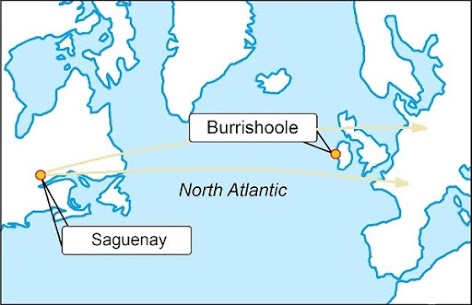
The locations of both Saguenay (Quebec, Canada) & Burrishoole (Mayo, Ireland) are shown. The fire extended across a wide region covering a ‘front’ of some 150 km, along the southern shore of Lac Saint-Jean (which is well to the west of the settlement of Saguenay), to a bay on the Saguenay Fjord, just to the southeast. The visual effect of the high-level smoke particles was reported from several places in Ireland and Britain as well and from western mainland Europe: there is more discussion of this event later and a map of NE Quebec (and adjacent regions) can be seen at Figure 4 (below).
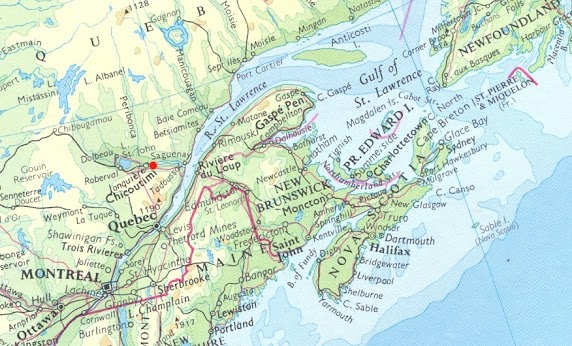
The spring had been unusually dry in this part of Canada – farmers had ploughed fields by early May for example, remarkably early. A huge forest / brush fire had broken out in an area of recently felled trees, with a strong wind fanning the flames, and the ‘wildfire’ spread rapidly (no doubt generating its own enhanced wind field), and the plume of smoke penetrated high into the troposphere [the ‘weather’ layer of the atmosphere]. The fire spread so quickly and was so intense that some only had enough time to reach safety of the nearest area of water to survive without their valued possessions – and of course agriculture was severely impacted; over 500 farming families lost everything they had. By evening on 19 May, the fire had largely burnt itself out, but by that time a huge plume of smoke particles was being carried towards the east (and eventually Europe) on the upper winds – giving rise to the optical effects noted. There is more on this fire, the optical effects etc., in a separate section . . . HERE.
Haymaking in July of the following year of 1871 was seriously hampered by persistent, often heavy rain; in the Armagh record, over twice-average rainfall (relative to the 1981 – 2010 dataset) was recorded and this is probably indicative of conditions elsewhere across Ireland. Broadly though no major impacts are noted for the farming community – and the harvest months of August and September were favoured by lengthy periods of dry weather.
1872 was to prove pivotal for John Oram personally and for Ireland. As across much of the British Isles, this was a notably wet year and the diary entries record the difficulties – it was ‘devastating’, in the true dictionary meaning of that word, to the already poor tenants in this part of Ireland. January was . . . wet and rough; it was a . . . bitter, cold April followed by a . . . cold May. There were frequent periods of rainy days in June, on average the time of year with a low frequency of rain-days (Figure 5 below) though July was broadly quite a decent month; but August, when the harvest would have started in earnest, heralded a significant downturn in conditions.
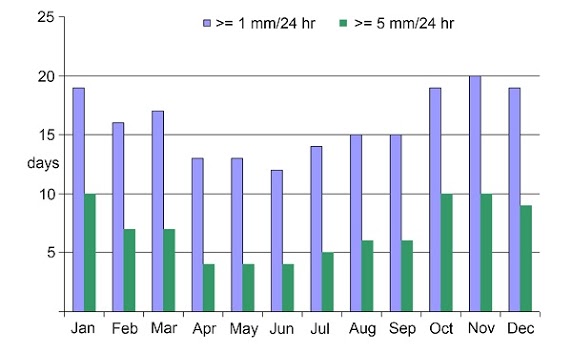
Figure 5: Average number of 24 hour periods for each month with defined precipitation amounts at Belmullet – see Figure 1 [above] for location. (Met Éireann).
Several days in the first half of the month had remarks such as . . . pouring rain or . . . very wet and at the end of the month it was . . . too wet to draw turf. September and October were wet months: on 2 September, he actually notes rainfall duration [ 34 hours ] and the remainder of the month had a marked excess of days with heavy rain falling. On 10 October there is the note . . . great floods. The rain continued and referring to the Armagh data elsewhere in the island, for the period September 1872 to January 1873, the total precipitation was 553 mm, or over 145% of the modern long-term average. The calendar year of 1872 was one of only seven years (in the record 1838 to 2001) to exceed 1000 mm accumulated precipitation.
In his end-of-year summary (for 1872), he writes thus . . . and this ends the wettest year on record not only as regards Ireland but all Europe [. . .] by far the wettest year on record [. . .] a memorable year to me as on the 2nd Oct. I was shot at, at 2 O’Clock P.M. a mile beyond Dughill. The ball passing through my macintosh and under coat by God’s blessing I escaped unhurt – in consequence of this I surrendered Mr. Vaughan’s Agency, and tried to get a farm in England [. . .] Oats a damaged crop – hay scarce and dear. (For the location of Dughill see Figure 1 above).
The poor weather of 1872 affected much of Ireland and from the edition of British Rainfall for 1872 there are reports at the end of the year that describe the effects of the high rainfall; from Enniscorthy, County Wexford (in the southeast of Ireland) . . . ” The country is saturated, the town is flooded and the rivers far beyond their bounds. No wheat is sown, and in many places the potatoes are still in the ground “. An observer in County Londonderry, in the north of the island notes . . . ” The harvest very bad [. . .] about half the year’s fuel is still in the bogs. Potatoes and turnips on heavy lands are very bad “.
It is not appropriate here to dwell on the political unrest enveloping much of Ireland (which, remember, was part of the United Kingdom) at this time, but distress amongst the Irish rural population, exacerbated by decline in agriculture was reaching a critical level by the 1870s – and County Mayo was at the heart of a movement that would eventually lead to the partition of the island – after a long and bitter struggle.
John Oram, along with his family, was in a difficult position, being both a tenant and an agent of English landlords. It is obvious from entries in his diary that for various reasons he was finding it hard to extract rents due. After being shot at in early October, he was often provided with a police escort when visiting remote areas – a restriction he found irksome. However, Oram was held in high regard by many in the community; after the attack on his life, many of the tenants he had dealings with signed a published manifesto expressing their . . . “abhorrence of the atrocious and dastardly attempt” (on his life). Mayo is in one of the wettest parts of Ireland. The total (average) precipitation across much of the county is 1600-2000 mm per annum, so problems with heavy rain for farmers here, as elsewhere along the Atlantic coasts, would be expected. Remembering what had gone before – and that agriculture was always a marginal pursuit in the region, the excessively wet and ‘backward’ year of 1872 brought misery to many small tenant farmers / smallholders.
John Oram returned with his family to England in October 1873, and took up a farm tenancy in Sussex, where he continued his farming diary; this phase of his life will not be discussed here.
However, in summer 1877 he went back to Co. Mayo: the diary resumes – and so does the rain. Of the 15 days he records weather in his first month back in Ireland (July) four are noted as being . . . very wet, and the frustration bursts out of the page on 24 July . . . rain, rain – still. August is little better with the majority of days recording rain in some form. The foul weather lasted until 13 September when . . . great storm of wind and rain is noted. This event obviously heralded a major change of type as the remainder of September and the first week of October he regarded as . . . much (the) finest weather this summer. But the wet summer had its effect – Oram records . . . Potatoes very bad on 30 September. In October, he twice recorded events connected with non-payment of rents as rural distress, allied to political agitation gathers pace. Tenants were to suffer further assaults on their subsistence living as winter closed in – November, December & January (1878) had frequent entries that imply extended spells of excessively wet conditions.
But overall 1878 appears to have been a fair year for farmers – July and the first week of August are noted as being dry and warm, or even hot – and no adverse comments surrounding the potato crop are entered.
But if 1878 was relatively benign, in 1879 poor growing and harvesting conditions returned to this corner of Ireland. And the political tension spreading across Ireland increasingly intrudes into the diaries as into John Oram’s life. His year-end notes perhaps sum up the situation well . . . thus ended 1879 – the most disastrous year for farmers on record . . . potatoes much diseased . . . much distress among the poor – rents badly paid . . . much distress expected before next harvest. In September he recorded that he had despatched a tenants’ petition, with covering letter from the local priest to the landlord in England, and in a short note at the end of his diary for that year, he notes . . . land league started this year.
The Irish Land League, led by the Irish MP Charles Stewart Parnell, had its origin in Co. Mayo, prompted by resentment at the failure of landlords to relax rental demands following bad harvests and to recognise the problems that rural tenants faced. The League organised boycotts of rent payment, defied enforcement of what were seen as punitive leasehold conditions and in some cases, physically blocked evictions for non-payment. In 1881, the UK government introduced the Land Act that granted official rent reductions and gave a small measure of protection to tenants. In the following year Parnell negotiated government write-off of unpaid rents – in return the League was disbanded. But of course the story continued . . . .
But by now, John Oram was back in England, and his county of birth, Somerset. He had witnessed much and been a part of momentous events – and we have the good fortune to read his contemporary record of much that took place.
Acknowledgements: I am grateful to the descendants of John Oram – Charlotte Oram, Christopher Oram and Carolyn Sturdy, for encouragement in this task. In particular, Carolyn Sturdy, John’s great-great-granddaughter not only provided the copy of the diary referred to in my introduction, but was the ‘conduit’ to the rest of the family.
The diaries of both John Oram and his son Arthur (who also farmed in Ireland) have been deposited with University College Dublin Archives with a reference IE UCDA P258.
They may be consulted on prior application: more details will be found at http://www.ucd.ie/archives/html/collections/oram-john-arthur.html.
Carolyn Sturdy and her brother, Christopher Oram, have produced a web site that gives much important background to the family history as well as some interesting images.
It may be accessed at: http://familyhistory.oram.ca/burrishoole/.
Martin Rowley, May 2014
References:
Alexander LV & Jones PD. 2001. Updated precipitation series for the UK and discussion of recent extremes. Atmospheric Science Letters doi:10.1006/asle.2001.0025
Booth B.J. 1970. The Royal Charter. Weather, 25: 550-553.
British Rainfall. 1873. British Rainfall 1872, London. Downloaded from the Met Office site at http://www.metoffice.gov.uk/archive/british-rainfall
García-Suárez AM, Butler CJ, Cardwell ADS, Coughlin A, Donnelly DT, Fee KR, Hickey KR, Morrow B, Taylor T. 2002. Meteorological Data recorded at Armagh Observatory from 1795 to 2001: Volume 1 – Daily, Monthly and Annual Rainfall 1838 – 2001. Available at http://climate.arm.ac.uk/ [accessed 21 March 2014].
Kelly J. 2012. The Great Famine and the Saga of the Irish People. Henry Holt & Co: New York
Lamb H.H. 1982. Climate, history and the modern world. Methuen: London and New York
Lamb H.H. 1991. Historic Storms of the North Sea, British Isles and Northwest Europe. Cambridge University Press: Cambridge
Maury T.B. 1873. The Law of Storms Developed (published in) The Popular Science Monthly, February 1873: Wikimedia
Sweeney J. 2014. Regional weather and climates of the British Isles – Part 6: Ireland. Weather, 69: 20-27.
Wallace JM & Hobbs PV. 1977. Atmospheric Science: an introductory survey. Academic Press, Inc. (London) Ltd: London
[ Web site links are notoriously unreliable! If those above fail, use a good search engine to locate the relevant information. ]
The Royal Charter Storm . . . October 1859
The disaster . . .
The fact that John Oram didn’t make any note of what has become known as the ‘Royal Charter Storm’ is significant – because at the time, it was directly responsible for the loss of over 130 vessels around the coasts of Britain and a death toll (both sea-borne lives lost & deaths on land due falling masonry etc.) of around 800.
In the case of the Royal Charter, which gave its name to the storm, over 450 of the passengers* and crew died. The ship ran aground on the north-east coast of Anglesey near the village of Moelfre (early hours 26th October, 1859). There then began a frantic & rather chaotic evacuation attempt, hampered by both the wild conditions and the “blackness of the night”. Before these efforts could achieve fruition, the vessel was pounded to destruction by stormy winds and giant waves – eventually breaking up by first-light that day (Figure 6 . . below); just 25-30 souls survived the disaster.
[* There is doubt about the exact figures as the passenger manifest was lost in the wreck.]
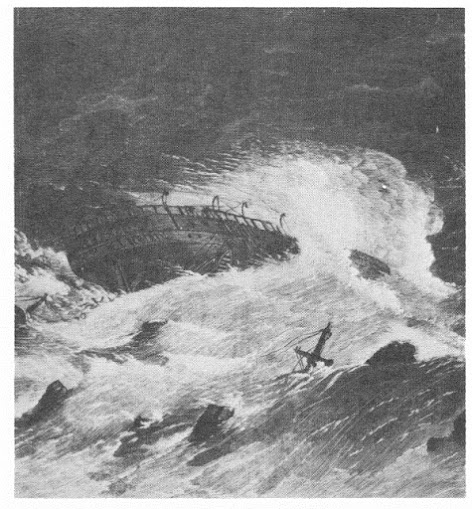
Figure 6: An artist’s impression – based on first-hand reports – of the wreck of the Royal Charter on the shore-line at Moelfre, Anglesey.
FitzRoy – and ‘forecasting’ . . .
In 1854, Captain Robert FitzRoy RN (image in article below) was appointed as the Head of a new department of the Board of Trade [BoT], charged with the responsibility of collecting weather data from BoT registered ships putting in to UK ports. He had to coordinate the issue and calibration of equipment and arrange for standardised recording practices: there was no thought at this time of any ‘forecasting’ purpose to all this – for one very good reason that such reports were not received in ‘real-time’.
However, FitzRoy had throughout his career been interested in the prediction of weather events – principally by use of the barometer. He performed an analysis of the storm (Figure 7) using the data available to him – which became the basis for much work around that time by others, most notably in the United States and France. He became convinced that a system of warnings could be used and FitzRoy developed a theory of “forecasting the weather” using 15 coastal recording stations, the fledgling telegraph service and plotted charts. This system came into use in 1860 – the ‘forecasts’ being published in The Times. At the same time, the Board of Trade distributed ‘storm glasses’ to FitzRoy’s design to some coastal communities around the kingdom.
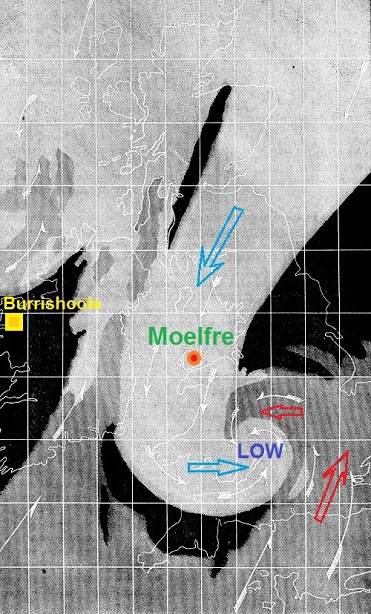
Figure 7: FitzRoy’s analysis of the storm which led to the wrecking of the Royal Charter, amongst other disasters around the British coastline; the location of Burrishoole (where John Oram was recording weather conditions) is indicated, as is that of Moelfre. The blue arrows indicate cool (or Polar Maritime) air mass, the red arrows warm (or Tropical Maritime) air mass. More information is contained in the text below.
The background (black-grey-white) image was Robert FitzRoy’s attempt at the time to analyse the weather pattern on the day of the ‘Royal Charter’ storm. The time is roughly when the ship was being subjected to the highest winds from this system – around dawn (or soon after) on the morning of the 26th October, 1859. Light grey shading was used by FitzRoy for ‘polar’ air streams (i.e., cold air drawn from north of the British & Irish Isles) and darker grey for ‘tropical’ air streams flowing up from the SSW: the conflict between the two being most intense in the vicinity of the low pressure.
Superimposed on this basic diagram [taken from Maury, 1873], in colour, are the locations of Moelfre (Anglesey), the place where the vessel came to rest – subsequently breaking-up – also Burrishoole (Co. Mayo), where John Oram was living at the time. As can be seen, NW Ireland was well away from the area of strongest winds. Also shown for emphasis are arrows showing the flow of warm [red] and cold [blue] air.
In 1861, the ‘forecasting’ system went one stage further with the establishment of a network of signal stations around the coast at major ports: if a gale was anticipated, a telegram was issued for the appropriate cones / barrels to be hoisted – this system lasted well into the latter half of the 20th century. All these developments are the forerunners of the work of the modern day Meteorological Office (now more simply known as the “Met Office”).
Robert FitzRoy, RN (later Vice-Admiral Robert FitzRoy, FRS)
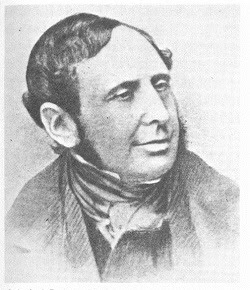
Robert FitzRoy ( 1805-1865 ) was a remarkable man. His reputation suffers by virtue of his denial of the work of Charles Darwin, who was his companion and scientific recorder for five years on his voyage aboard the Beagle ( 1831-1836 ). At the end of his life, FitzRoy vehemently objected to Darwin’s findings, presented in the latter’s On the Origin of Species. Darwin proposed the ‘evolutionary’ theory of natural selection and development of life-forms; FitzRoy believed passionately that the answer lay in the teachings of the Christian church and the Holy Bible. They were never reconciled.
But before all this, FitzRoy had a career full of interest. To most in after years, the fact that he was the captain of the ‘Beagle’ – a scientific survey vessel onto which he invited Darwin – has ensured that his name will not be forgotten. By and large, FitzRoy and Darwin got on well on the voyage and between them accomplished much – though there were periods of extreme tension (hardly surpising given the conditions) which may have laid the foundation for conflict in later years.
To a New Zealander, and particularly to the Maori, Captain FitzRoy is remembered as the second Governor of that country, ( 1843-1845 ) who was sent from the UK to attempt to bring order after friction and war between British settlers and the native people. Well ahead of his time, FitzRoy tried to redress the grievances of the Maori, but this was not welcome by the settlers and they frustrated his attempts, eventually getting London to recall him.
He saw more active service in the Navy, ashore and afloat, before, in 1854, he was appointed to the post of head (or ‘statist’) of the newly created meteorological department of the Board of Trade. With a small staff FitzRoy’s task, one for which he was eminently suited, was to collect and coordinate the weather observations made by ships registered with the Board. In 1857, he was promoted to the rank of Rear-Admiral (based on seniority).
As noted in the main text the disaster of the Royal Charter led to his formulation of the idea of ‘forecasting’ the weather – a term he probably coined, and as such, to meteorologists having their roots in the British service, we regard FitzRoy as our ‘founding father’. In 1863, he was promoted for the final time to Vice-Admiral.
In the last years of his life, public criticism, personal crises and perhaps his quarrel with Darwin, saw FitzRoy become ever more depressed and in 1865, he ended his life by cutting his throat with a razor.
But Robert FitzRoy left a legacy of enquiry into the working of the atmosphere that would blossom into the highly sophisticated forecasting systems we have today. A glance at an atlas will show that his name is attached to several features around the globe, but appropriately, the name ‘FitzRoy’ is now an integral part of that British institution, the Shipping Forecast: a huge area guarding the SW Approaches to British waters carries his name and can be heard in the broadcasts four times daily on the BBC.
A fitting tribute to a man keen to develop the science of meteorology & thereby protect the lives of those at sea.
The Saguenay Fire . . . May 1870
The ‘strange’ appearance of the sun and sky . . .
John Oram was not the only person in western Europe to observe the ‘strange’ appearance of the sun and sky on the 22nd and 23rd May, 1870. His careful record (22nd) is remarkable though as it is made by a man with many calls on his time – and thus he must have been describing something of great interest: for the sake of completeness, his statement is repeated here . . . “Strange appearance of the sun rose quite red – got dark red at 10 o.c. pink at 1 fading into yellow after – so dim that it looked like the moon.”
Over the period 22nd / 23rd May (1870), there were several reports of unusual coloration to the sun; the exact colours are described differently, but initially white (not long after sunrise – this is at odds with Oram), then “purple side of red” or “dark red”, then as the sun climbed higher in the sky . . . “pink, inclining to purple”, seems to sum up the observations from a wide area of Ireland, Britain and western mainland Europe; the phenomenon lasted several hours at any one location and the overall sky was described as ‘hazy’ (implied high dust loading); observers described the sun as if “shining through smoke” and “so dim it looked like the moon”.
Some reported seeing sunspots on the solar disk – looking directly at the sun, even using opera glasses and as no ill-effects were noted, we must assume that the sun’s radiation intensity was significantly reduced.
Some specific reports: from Dunmurry, County Antrim (Ireland) . . . “The Sun shone pink inclining to purple through a haze during the afternoon”. The observer wrote, “I never before saw (the Sun’s) colour on the purple side of red”. Elsewhere, a pink Sun was widely seen in England, and also observed at Rohrbach on the Mosselle on the 23rd, where the Sun appeared ‘rose-coloured‘ through an afternoon mist. [Meteorological Phenomenon, Joseph John Murphy]
A letter to ‘Nature’ has this (composite extract) . . . “on the afternoon of Sunday, the 22nd, a very curious appearance was noticed by many. The sky was hazy, and the sun was seen through the haze of a pink colour, inclining to purple. I see by a newspaper that the same was noticed at Dublin. A red or orange sun is common, but I never before saw its colour on the purple side of red”.
Looking at Symons’ “British Rainfall” publication for 1870 (available now on the Met Office web site – see link below), on the 22nd the observer at Norwood Cottage [unclear as to the exact location, but probably in Ireland] records . . . “sun’s disc visible through a thin covering of cloud”. And from the same publication, at Ballinasloe (Co. Galway) . . . “curious appearance of sun through red clouds”.
[ Link for the Met Office site (search for “British Rainfall”): . . . HERE ]
Here are more reports of the ‘strange’ optical phenomenon, obviously widely observed over Ireland and one or two other parts of the British Isles. J.W. Moore writes: . . . “Through the canopy of cirrostratus the sun now came into view, being at first of a pale white colour, but soon assuming a pinkish or carmine tint. A strange lurid light spread over the landscape and it seemed as though a total eclipse was in progress. For some hours the sun was seen under these circumstances and several spots were noticed scattered over the disc […] the cloud which produced the appearance just described, no doubt was a vapour-fog suspended in mid-air, the motion of which was extremely slow. The extent of this cloud formation was remarkable. It was noticed in Wicklow, Dublin, Meath, Cavan, Connemara, Louth and Antrim”. Unfortunately, the location of Mr. Moore’s report is not stated in the entry I have!
Another report, again without a location though thought to be in Ireland . . . “On Sunday last it was remarked that the sun had a strange bright copper colour and when looked through an ordinary opera glass, eight spots were distinctly visible on lower half of disc. The atmosphere was thick and indeed the sun seemed as if shining through smoke”. As noted elsewhere, the fact that the sun could be viewed through a magnifying instrument suggests a significant reduction in solar radiation.
From Bailieborough (Co. Cavan) . . . “From a very early period of the day until late in the evening, groups of people might be seen gazing heavenward, some of them betraying by their looks evident apprehension of danger and all of them more or less emotions of interest or astonishment, while they continually inquired from one and the other: ‘What is the matter with the sun?’ Young, old, rich and poor were attracted by the strange and varied attire with which ‘mighty Sol’ decorated himself ever and anon exhibiting almost lightning rapidity, dresses of every tint and colour, simple and compound: light pink, blood, red, purple, green, blue, yellow and then bright like silver”.
Then at Inniskeen Rectory, Dundalk (Co. Louth) . . . “The obscuration of the pink veil lasted until 5 o’clock. During its prevalence all terrestrial objects presented a strange lurid appearance, like exhibited during a solar eclipse. There were many spots on the face of the sun, some of them large enough to be seen with naked eye, which required no defence of darkening glass even in the focus of a three inch glass telescope. The phenomenon was very beautiful and not alarming”. Again, note the implied marked reduction in solar intensity!
Another (Irish but location unspecified) report . . . “9am to 3pm curious appearance of the sun changing from red to pale violet, there was a dense and peculiar cloud passing high up from the earth; horizon clear”.
And finally, times only – Dublin: 1pm to 5pm, Tynemouth: 5pm and Cambridge: 10am on 23rd.
These reports were all made at the time – and published largely independently of each other – and it is obvious that for some decades afterwards, the phenomenon was not attributed to a significant fire; for example, the following is taken from ‘Astronomical Curiosities: Facts and Fallacies‘, by J. Ellard Gore (London / Chatto & Windus) which was published in 1909 . . . “A remarkable instance of sun-darkening recorded in Europe occurred on May 22, 1870, when the sun’s light was observed to be considerably reduced in a cloudless sky in the west of Ireland, by the late John Birmingham; at Greenwich on the 23rd; and on the same date, but at a later hour, in North-Eastern France: a progressive manifestation . . . Mr. Birmingham says, ‘that seems to accord well with the hypothesis of moving nebulous matter’.”
The physics of smoke & light in the atmosphere . . .
Smoke, dust, haze particles etc. have radii circa 0.1 micro-metres. The scattering of sunlight by such particles falls within the “Mie” regime. Usually such particles exhibit a spectrum (or range) of sizes wide enough such that the differential scattering of incident light renders what the eye sees as a neutral or whitish hue – the common case.
However, if the particles are quasi-uniform in size, as would be the case from a single, intense source such as a brush / forest fire, the scattered sunlight due to such particles will be either bluish or reddish in hue as in the case outlined here – with variations that are dependent upon the solar angle, the particular part of the smoke plume that is passing overhead and the concentration of same – with time of course, the concentration decreases and the effects lessen.
There can be no other explanation for the particular observations recorded other than a major fire – and given the events below, we can confidently tie the ’cause’ to the ‘effect’.
The Fire and its consequences . . .
Spring 1870 was notably dry across Quebec. It was so dry for example that farmers across the Province had mostly ploughed their fields by early May of that year. The Saguenay area [Figure 4 above] in the nineteenth century was populated by people performing the tasks of farming and forestry – with relatively small, well-scattered settlements.
How the fire started, on the 18th May, is not clear – but the source was thought to be in an area where forest clearing operations were in progress; it’s possible that a small fire lit either for cooking purposes or for scrub / debris clearance was allowed to get out of control. The fire, once started, developed rapidly amongst the dry timber – fanned by an already strong breeze – and generated its own heat-driven wind. The fire then spread quickly through the 18th and much of the 19th May and was so intense & spread so rapidly that many families only had time to reach safety or the nearest area of water – abandoning their possessions. Some people had to stay in water for hours whilst the fire burnt down, or they were able to be rescued – the intensity of the heat was such that the fire jumped alarmingly from one area of scrub, brush or timber to another.
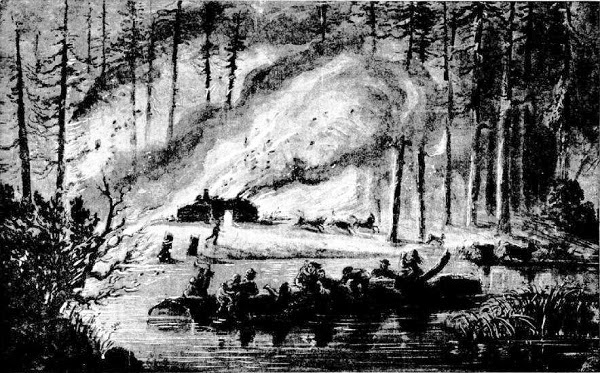
The area affected lay between the Mistassini River, near Lac St-Jean and Baie des Haha covering some 150 kilometres (just under 100 miles): the area is estimated at some 4000 square kilometres (or 400 000 ha, nearly 1 million acres); over 500 families, representing nearly one third of population in the Saguenay region lost all their possessions – as everything in the path of the fire was destroyed – personal property as well as public bridges and buildings.
By evening on the 19th, the fire had largely burnt itself out and an ‘eerie calm’ settled over the devastation; but not before it had produced huge quantities of fine ash – the plume of smoke / soot particles was carried towards the east (and eventually to Europe) on the upper winds (see below).
Surprisingly few lives were lost (5 deaths is the figure generally quoted), but many people were seriously burned (many due to the intense heat radiation as well as the more normal contact burning by flame). Cut off from the rest of Canada & the near USA, and with poor communications, the victims were reduced to building crude huts from scorched tree trunks and sleeping on the ash-covered ground. A disaster relief committee was eventually set up and began distributing food, seed, clothing and other supplies sent in from parishes along the St. Lawrence and from the large dioceses in Montréal and Québec City. As a result of newspaper coverage describing the terrible plight of the victims, aid from across the Province began to come in. However, it was many years before the region recovered fully from this disaster.
As is common in these types of fire, the lower atmosphere assumes a ‘super-adiabatic’ lapse rate [the temperature falls rapidly with height from the hot surface for a 1000 m or so] due to intense surface heating – allowing vigorous upward currents to carry the smoke / soot particles (along with other, larger debris) high into the troposphere; the larger particles will fall out not far from the source but the tiniest products of the combustion process will be carried well clear of the seat of the fire – and then moved in the direction of the prevailing mid / upper tropospheric wind – circa 600 to 400 mbar [roughly 4 to 7 km altitude].
As regards the path of the minute smoke (or soot) particles, the distance Saguenay – Mayo is approximately=2350 nmi / 4300 km. The fire was declining rapidly by the evening of the 19th May (see above), yet had ‘occurred’ on the 18th, and given the obvious destruction, it must have been an intense / hot source – pushing a large quantity of smoke/ash into the atmosphere within a period of 24 to 30 hours. John Oram (along with others in Ireland) observed the effects on the morning of the 22nd – from sunrise (deep red) throughout the morning, and well into the afternoon. Assuming a nominal ‘start’ time of 0900 GMT 18th, and a nominal ‘arrival’ time of 0900 GMT 22nd, this gives an elapsed period of 4 x 24 hours=96 hours. The plume, travelling 2350 nmiles in 96 hours has an average speed of 24 knots. If the plume actually arrived overnight (which, given Oram’s report of the effect at sunrise is quite likely: say 0300 GMT), then this increases the speed to 2350/90=26 knots: a working figure of around 25 knots would then seem to be the best approach.
This sort of speed is quite low for the middle part of the troposphere (the ‘weather’ zone) – and implies that we’re not dealing with an active jetstream or anything approaching that strength. But at the same time, the flow must have been close to being ‘zonal’ in character (i.e., a wind from due west to east); any large-scale meanders in the flow would imply a good deal of turbulence which would disperse the sooty particles to such an extent that any optical effect would be small.
Nowadays of course, we would be able to analyse the trajectory, altitudes, composition etc., very quickly – but in the 1870s no such methods were available. It was many decades before the link was made between the optical phenomenon and the Saguenay fire.
